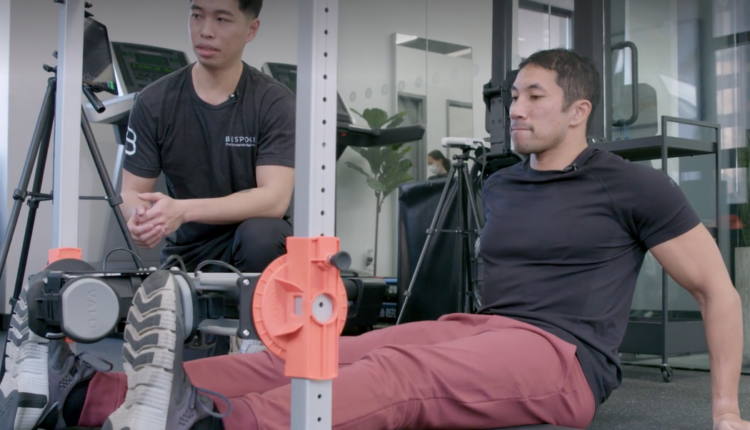WHEN YOU’RE INJURED, you won’t be as strong as you would be when you’re healthy. That’s just simple logic. But muscle imbalances and weakness might linger on even after you’ve recovered from the most glaring effects of an injury—and that could make a world of difference for your workouts and, more broadly, your quality of movement.
Men’s Health fitness director Ebenezer Samuel, C.S.C.S. is in that position. He’s healthy—but he has a history of lower body injuries, like an ACL tear he suffered in his college days. Samuel visited Bespoke Treatments in New York City to work with Dr. Samuel Chan, DPT, ATC, C.S.C.S. to determine exactly how strong his lower body is and how he might be able to train for better performance.
“What we need to do is look at your muscle strength and break it down by each muscle group, and also between both sides to make sure there’s no real asymmetry or strength deficits or differences from limb to limb,” Chan told Samuel during the visit. To do this, Chan used the VALD Performance ForceFrame to use to collect hard data. Physical Therapists can use the device to determine how strong muscles are without cheating. The high-tech assessment can identify strengths and potential weaknesses of individual muscles.
Understanding exactly what Chan measured is important. Most people conceive of strength in terms of amount of weight lifted—i.e., how many weight plates you can stack on a barbell to pull off the floor for a deadlift or perch on your back to lower down for a squat. These are examples of concentric and eccentric contractions (the shortening and lengthening of your muscles, respectively). But there’s also isometric contraction, which is when you contract a muscle and hold it without movement.
This is what Chan measured to determine the peak strength of Samuel’s muscles, since the other compound movements make it easier to mask imbalances and inefficiencies when the muscles work together. “If we want to isolate and really identify the weakness in one body part, that’s where this Frame comes into play,” Chan said.
Chan led Samuel through a lower body assessment that consisted of seven different exercises that tested the strength of the hip, knee, and ankle. Samuel pushed against the ForceFrames sensors in various positions for five second isometric holds, rested for 10 seconds, then repeated the contraction again for three total rounds in each position.
Samuel was surprised with how the assessment went. “Honestly, I expected to uncover even more asymmetries than the test did,” he said. “I’ve played sports and strength-trained for most of my life, so I assumed I’d have even more overcompensations than an average person.”
There was one major discovery. “The biggest thing we uncovered, though, was a difference between hamstring and glute balance on my left and right sides,” Samuel said. “I create similar hip extension force with both legs, but how I get there is different: On the left side, I’m using a lot more glute than hamstring. On the right side my hamstring plays a more key role in that hip extension than my glute.”
Having a PT to collect the data—and more importantly, interpret the findings—helped Samuel to understand exactly how to move forward. “The moment Dr. Chan mentioned that, I understood why I’ve had a history of hamstring pulls and strains on my right leg: My hamstring is working overtime,” Samuel continued. “That’s a tiny insight I’d never have picked up on before, and it’s allowed me to tweak my training in smart ways: To bring my left-leg hamstring into balance, I’ve added more single-leg hamstring isolation work into my training.”
One of the most important parts of the whole process is understanding that where Samuel is now is not where he will necessarily be in the future—if he puts in the works, of course. “In a few months, I’ll retest on the ForceFrame hoping for different results—and maybe learning of a new imbalance I can clean up in my effort to be the best, strongest version of myself,” he said.
Brett Williams, a fitness editor at Men’s Health, is a NASM-CPT certified trainer and former pro football player and tech reporter who splits his workout time between strength and conditioning training, martial arts, and running. You can find his work elsewhere at Mashable, Thrillist, and other outlets.
Ebenezer Samuel, C.S.C.S., is the fitness director of Men’s Health and a certified trainer with more than 10 years of training experience. He’s logged training time with NFL athletes and track athletes and his current training regimen includes weight training, HIIT conditioning, and yoga. Before joining Men’s Health in 2017, he served as a sports columnist and tech columnist for the New York Daily News.




Comments are closed.